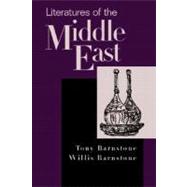
Literatures of the Middle East
by Barnstone, Tony; Barnstone, Willis-

This Item Qualifies for Free Shipping!*
*Excludes marketplace orders.
Buy New
Rent Textbook
Used Textbook
We're Sorry
Sold Out
eTextbook
We're Sorry
Not Available
How Marketplace Works:
- This item is offered by an independent seller and not shipped from our warehouse
- Item details like edition and cover design may differ from our description; see seller's comments before ordering.
- Sellers much confirm and ship within two business days; otherwise, the order will be cancelled and refunded.
- Marketplace purchases cannot be returned to eCampus.com. Contact the seller directly for inquiries; if no response within two days, contact customer service.
- Additional shipping costs apply to Marketplace purchases. Review shipping costs at checkout.
Summary
Table of Contents
SUMERIAN, AKKADIAN, AND EGYPTIAN LITERATURES.
The Pyramid Texts (funeral poems) (Egypt) (2464-2355 B.C.).Enheduanna (poems) (Sumer) (c. 2300 B.C.).
from The Epic of Gilgamesh (epic poem) (Babylonia) (c. 2000 B.C.).
Adapa: The Man (myth) (Babylonia) (2nd millennium B.C.).
The Shipwrecked Sailor (story) (Egypt) (c. 2040-1650 B.C.).
Tale of the Doomed Prince (story) (Egypt) (c. 2040-1650 B.C.).
The Book of the Dead (spells) (Egypt) (c. 1500 B.C.).
Ancient Egyptian Love Poems (poems) (Egypt) (1554-1085 B.C.).
BIBLICAL LITERATURE: OLD TESTAMENT, NEW TESTAMENT, AND INTERTESTAMENT.
Introduction.The Old Testament (11th century to 1st century B.C.) Israel.
Genesis.
Job.
Songs of David (Psalms).
Ecclesiastes, or the Preacher.
The Song of Songs.
Isaiah.
Daniel.
Jewish Apocrypha.
NEW TESTAMENT (55-100).
Matthew (gospel) (Israel or Syrian Antioch) (A.D. 80-110).Mark (gospel) (Israel, Syria, Alexandria, or Rome?) (after A.D. 70).
Luke (gospel) (Place of composition unknown) (A.D. 80-85).
John (gospel) (Ephesus?) (between A.D. 80-120).
Paul (letter) (Tarsus/Jerusalem) (A.D. 5 to A.D. mid-60s).
Revelation (Ephesus or Patmos?) (apocalypse) (100?).
INTERTESTAMENT: JEWISH PSEUDOEPIGRAPHA, DEAD SEA SCROLLS, JEWISH-CHRISTIAN ODES, GNOSTIC SCRIPTURES (2nd CENTURY B.C. TO 3RD CENTURY A.D.)
The Book of Jubilees (Israel/Alexandria) (2nd century B.C.).The Thanksgiving Psalms (Dead Sea Scrolls) (Israel) (1st century A.D.). Introduction to Gnosticism.
The Gospel of Thomas (prophecies, proverbs, and parables of Jesus) (Syria, Palestine, or Mesopotamia) (c. A.D. 200).
The Odes of Solomon (Syria?) (2nd century).
The Hymn of the Pearl (narrative poem) (Syria?) (2nd or 3rd century).
On the Origin of the World (Gnostic genesis) (Greek/Coptic Egypt) (3rd century).
NEOPLATONISM.
Plotinus (Neoplatonic philosophy) (Alexandria, Egypt) (205-270).EARLY ARABIC LITERATURE.
Al-Khansa (poems) (Arabia) (575-646).Muallaqat (The Suspended Odes) (Arabia) (6th-early 7th centuries).
The Quran (Arabia) (7th century).
Rabia the Mystic (poems and miracle story) (Iraq) (712-801).
Abu Nuwas (poem) (Persia/Baghdad) (b. between 747-762, d. between 813-815).
The Thousand and One Nights (tales) (Baghdad, Iraq) (c. 9th-14th centuries).
Usamah Ibn Munqidh (memoir) (Syria) (1095-1188).
POEMS OF ARAB ANDALUSIA.
Introduction (711-1492).Ibn Shuhayd (Córdoba) (992-1034).
Ibn Hazm (Córdoba) (994-1064).
Solomon Ben Gabirol (Hebrew) (Máaga) (c.1021-1022-c.1055).
Ibn Ammar (Sevilla) (1030-1083).
Ibn Burd (Córdoba) (d. 1053).
Judah Halevi (Hebrew) (c. 1075-1141).
Abu l-Hasan Al-Hursi (Eastern Andalusia) (d. 1095).
Ibn Abi l-Haytham (uncertain period).
Ibn Iyad (Central Andalusia) (1083-1149).
Abu l-Hasan Ibn Al-Qabturnuh (Badajoz) (d. 1134).
Abu l-Qasim al-Manisi (Sevilla) (12th century).
PERSIAN LITERATURE.
Ferdowsi (epic poem) (Persia) (c. 940-1020).Omar Khayyam (poems) (Persia) (c.1048- 1131).
Attar (Farid Ad-Din Attar) (poems) (Persia) (c.1120-1220).
Rumi (poems) (Persia/Turkey) (1207-1273).
Sadi (prose and poems) (Persia) (1184-1292).
Hafiz (poems) (Persia) (c. 1320-1390).
MODERN ARABIC, HEBREW, TURKISH, ALEXANDRIAN GREEK, AND PERSIAN LITERATURES.
Introduction.Traditional Song (Algeria) (from uncertain period).
Constantine Cavafy (poems) (Alexandria/Egypt) (1863-1933).
S. Y. Agnon (story) (Israel) (1888-1970).
Nazim Hikmet (poem) (Turkey) (1902-1963).
Naguib Mahfouz (story) (Egypt) (1911-).
Mririda Nait Attik (poems) (Berber) (Morocco) (c.1919-).
Yashar Kemal (story) (Turkey) (1922-).
Nizar Qabbani (poems) (Syria) (1923-).
Yehuda Amichai (poems) (Israel) (1924-).
Badr Shakir al-Sayyab (poems) (Iraq) (1926-1964).
Yusuf Idris (story) (Egypt) (1927-1990).
Joyce Mansour (poems) (Egypt/England/France) (1928-1988).
Adunis (Ali Ahmed Said) (poems) (Syria/Lebanon) (1930-).
Dan Pagis (poems) (Israel) (1930-1986).
Nawal Al-Saadawi (story, memoir) (Egypt) (1931-).
Forugh Farrokhzad (poems) (Iran) (1935-1967).
Reza Baraheni (poem) (Iran) (1935-).
Dahlia Ravikovitch (poems) (Israel) (1936-).
Haydar Haydar (story) (Syria) (1936-).
Mohamed el-Bisatie (story) (Egypt) (1938-).
Amos Oz (story) (Israel) (1939-).
Mohammed Mrabet (story) (Morocco) (1940-).
Mahmud Darwish (poems) (Palestine/Lebanon) (1942-).
Hatif Janabi (poems) (Iraq/Poland) (1955-).
Khaled Mattawa (poems) (Libya) (1964-).
Excerpts
An electronic version of this book is available through VitalSource.
This book is viewable on PC, Mac, iPhone, iPad, iPod Touch, and most smartphones.
By purchasing, you will be able to view this book online, as well as download it, for the chosen number of days.
Digital License
You are licensing a digital product for a set duration. Durations are set forth in the product description, with "Lifetime" typically meaning five (5) years of online access and permanent download to a supported device. All licenses are non-transferable.
More details can be found here.
A downloadable version of this book is available through the eCampus Reader or compatible Adobe readers.
Applications are available on iOS, Android, PC, Mac, and Windows Mobile platforms.
Please view the compatibility matrix prior to purchase.
